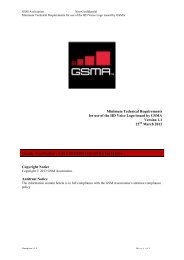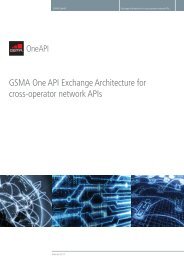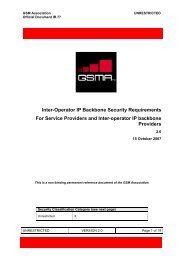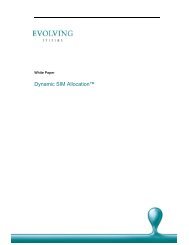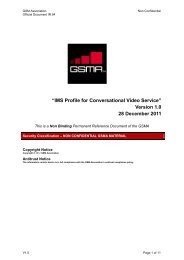Download here - GSMA
Download here - GSMA
Download here - GSMA
You also want an ePaper? Increase the reach of your titles
YUMPU automatically turns print PDFs into web optimized ePapers that Google loves.
OMTP VISUAL VOICEMAIL INTERFACE SPECIFICATION v1.2<br />
1 INTRODUCTION<br />
1.1 DOCUMENT PURPOSE<br />
The aim of this document is to provide a Technical Recommendation for an<br />
open and standardised Visual Voice Mail (VVM) interface protocol which VVM<br />
clients may use to interact with a voicemail server. The key functions of this<br />
interface will be support of:<br />
• Message Retrieval<br />
• Message Upload<br />
• VVM Management<br />
• Greeting Management<br />
• Provisioning<br />
The document will not define how a VVM client looks nor will it define the<br />
general behaviour of a client user interface or the manner in which a user<br />
shall interact with the user interface. The definition of the protocol may<br />
however imply certain client and/or user behaviours. The document intention<br />
is to ensure that standard functionality of voice mail servers may be accessed<br />
through a range of VVM clients via the defined interface. This approach<br />
leaves scope for operators and vendors to differentiate their products.<br />
1.2 BUSINESS RATIONALE<br />
The growth of VVM services and possible new business models is<br />
handicapped by the lack of a standardised client side interface to the voice<br />
mail server.<br />
Native support on terminals for such an interface will significantly improve the<br />
overall user experience, which in turn will encourage wider use of voice mail<br />
services.<br />
If vendors are able to support a single VVM interface their time to market and<br />
associated costs shall be reduced.<br />
A common interface definition shall allow client developers to focus on<br />
producing better clients rather than modifying clients to work with multiple<br />
interfaces.<br />
Having only one interface to support will improve the ability of an operator to<br />
provide the VVM service on a variety of terminals, roll out the service more<br />
quickly and contain operational expenditure.<br />
T<strong>here</strong> already are a number of VVM implementations in the market, however<br />
service deployment is at a nascent stage and so t<strong>here</strong> is still the opportunity to<br />
prevent market fragmentation. It is imperative that vendors and operators<br />
achieve quick agreement on the core VVM interface.<br />
© 2009 OMTP Ltd. All rights reserved. No part of this document may be reproduced or<br />
transmitted in any form or by any means without prior written permission from OMTP Ltd.<br />
Page 5 of 82<br />
OMTP PUBLISHED



